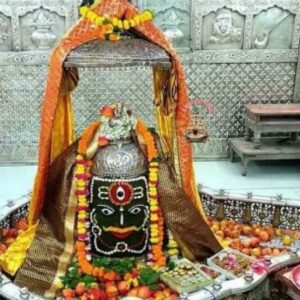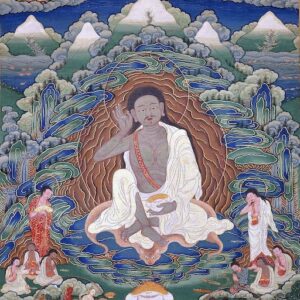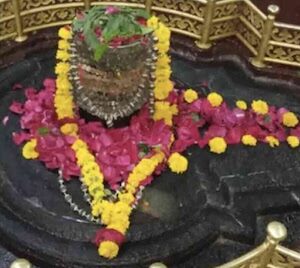This is mandapam in front of amman temple inside the Ramanathaswamy temple in Rameshwaram. You can go into meditative states here effortlessly.
How to Get There:
You can reach Rameshwaram Temple by taking an auto or taxi from train station.
Map: https://goo.gl/maps/QL5vroN7trAitJkV6
About Sukravara Mandapam
In this mandapam, there are idols representing the eight Lakshmis (Adi Lakshm Santana Lakshmi, Gaja Lakshmi, Dhana Lakshmi, Dhany Lakshmi, Jaya Lakshmi, Iswarya Lakshmi and Veer Lakshmi). In the eight pillars to the north of this Mandapan are the figures of Manonmani, Mahendri, Koumari Rajarajeswari, Lakshmi. Kali, Chamundi and the Dwarapalaka. The southern pillars are Dwarapalaka Sivadurga, Manonmani, Vageeswar, Setupati, Kadambi Thevar, Pradhani Bhuvaneshwari and Annapoorana.
About Sri Rameshwaram Jyotirlinga
Ramanathaswamy Temple, located in Rameshwaram (Tamil Nadu) is a Hindu temple dedicated to Lord Shiva, one of the gods in the trinity of gods. In the Tamil language, the temple is called, Irāmanātasvāmi Kōyil, which means house of Ramanathaswamy – i.e. Lord Shiva. This is how the city of Rameshwaram got its name. The word Rameshwaram has its origin in the Sanskrit language – (Rāma-īśvaram) and means “Lord of Rama” a term that refers to Lord Shiva, the presiding deity of the Ramanathaswamy Temple. Rameshwaram temple is one of the 12 Jyotirlings found in India. Jyotirlings are among the most sacred places, where Lord Shiva appeared himself in the form of a tall column of light, hence the name Jyotirling. In addition to being the Jyotirling, Ramanathaswamy Temple is one among the original ‘Chaar-Dham’ (4 sacred and religious places), located in the 4 corners of India. These ‘chaar-dhaams’ hold a very significant place for Hindus, who aspire to visit these temples at least once in their lifetime. As per the belief, a person should start the ‘Chaar-Dham yatra’ from Puri located in Odisha, east of India. Then one should move in a clockwise direction covering Rameshwaram in the second place, followed by Dwarika, and culminating in Badrinath. It is also one among the 275 ‘Paadal Petra Sthalams’, where the three of the most revered Nayanars (Saivite saints), Appar, Sundarar and Tirugnana Sambandar, sang divine songs in the praise of Lord Shiva. The word ‘thevalam’ in Tamil means ‘garland of divine songs’, and the term ‘Paadal Petra Sthalam’ means ‘the temples which are mentioned in thevalams’, or the divine songs. As a testimony to the legend of Ramayana, one can still find floating stones, using which Lord Rama had built a ‘setu’ (bridge) to Lanka. These stones are found near Dhanushkodi.
The legend goes back to the ‘Treta Yug’. According to Ramayana, Lord Rama (the seventh incarnation of Lord Vishnu), after killing Raavan, the demon king of Lanka was full of remorse. This is because Raavan was the son of a great saint, Vishrava, and hence, was a Brahmin himself. So, Lord Rama wanted to repent for this crime and hence prayed to Lord Shiva to forgive him for this crime. He decided to build a huge lingam to worship Shiva. So, he asked his ardent follower and one of the lieutenants in his army, Hanuman, to bring a lingam from Kashi. Since the worship was to be done at a pre-decided muhurat (particular auspicious time), and Hanuman was getting delayed in returning along with the ‘lingam’, Lord Rama worshipped a small lingam, which was made out of the sand by Maan Sita. This lingam, which was worshipped by Lord Rama is known as ‘Ramanathar’, or “Ramalingam’, and that’s how Rameshwaram got its name. When Hanuman returned with the lingam, he was disappointed that his Lord had not used the lingam that he had brought. Lord Rama pacified Hanuman & named this Lingam ‘Kasi Viswanathar’ or Kasilingam’. Another name for this is ‘Hanumanlingam’. Lord Rama blessed Hanuman that anyone coming to this temple would first need to worship this lingam (brought from Hanuman), before worshipping the lingam made by Maan Sita. So, this temple has two Shivlings – one made by Maan Sita and the other brought by Hanuman. As per the tradition, the devotees, who visit Ramanathswamy Temple, first offer prayers to ‘Kasilingam’ before worshipping ‘Ramalingam’





